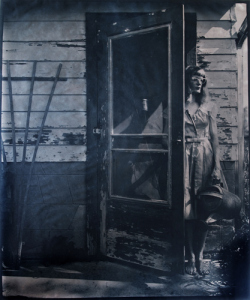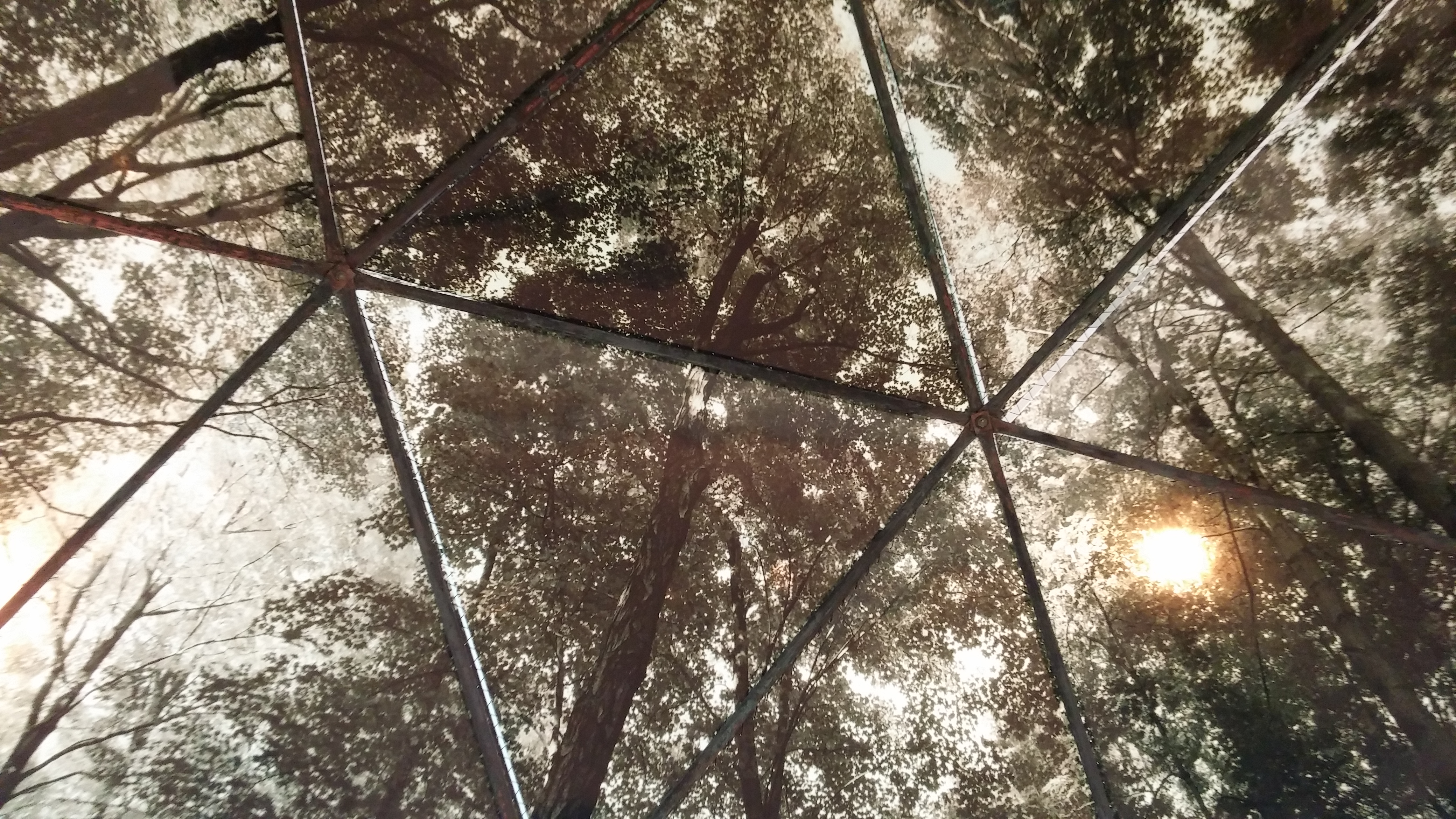
Shimon and Lindemann, “Self-portrait at Dusk, Whitelaw, Wisconsin,” 1998. Courtesy Milwaukeemag.com
There’s a Place: Photographs by J. Shimon and J. Lindemann, closing Sunday, June 7, The Museum of Wisconsin Art, 205 Veterans Avenue, West Bend, WI 262-334-9638 wisconsinart.org
John Shimon and Julie Lindemann have delved deeply into the nether reaches of Wisconsin existence for decades as photographic antiquarians. And matters of complex humanity emerge in the superlative retrospective of their joint artistic career, which closes this weekend at the Museum of Wisconsin Art. What makes it urgent to see are the facts that these are as important as any Wisconsin artists that we have right now, and that this first-ever museum retrospective of their work may be also the last one in the lifetime of this artistic duo, given Julie Lindemann’s declining health. 1
Consequently, There’s a Place has remarkable depth and emotional power, which also originates in the subtle dramatics they achieve in these encounters with their subjects, which convey in a larger sense their profound love for this state, for its people, culture and labors, and for its natural cyclical beauty.
Time after time, in the blow-up, largely black-and-white photographs, we see people — whom most others do not — revealed both because of and despite themselves. That revelation comes largely through the documentary acumen and instincts of the artistic duo. The longtime couple’s commitment to the Wisconsin experience through its people — especially its outsiders, working-class, punks and elderly — has resulted in a remarkable response to this exhibit, which may be the most popular in the museum’s history, according to Greg Cisler, a MOWA security guard and gallery guide.
“This weekend we had free admission and thousands of people came through,” Cisler said Saturday. “And many of them came out visibly affected at an emotional level. This couple has touched many people’s lives.”
Cisler says that Julie Lindemann did not even attend the April opening as she continues her battle with her late-stage metastatic cancer, diagnosed in 2012. It has spread to her hips, making it too uncomfortable for her to sit up straight, according to a recent Milwaukee Magazine interviewer.
And yet the tall, blond Lindemann you see posing in many of the photographs is a striking and almost theatrical visage. She generously displays her statuesque frame in various negligee and lounging attire, conveying strength in an arty-punk style and sexual self-assurance. So knowledge of Julie’s medical condition casts a poignant pall over these images.
That’s the danger in what they’re going through now, Julie told Milwaukee. “We never had pets, never had children…we kept shoveling it all into the art.”
But they do have their many friends, right here and through the state. The photographers got to know many of their subjects quite well. So there’s potency in the couple’s close scrutiny of their subjects combined with the latitude they allow them to just be themselves, but in the most self-possessed manner.
The irony is that the couple’s devotion to old, laborious and elaborate photography techniques, and typically silver gelatin prints, embraces a concept that befits and elevates today’s instantaneous, selfie-buzzed social media, in the sense that everyone involved is putting themselves out in a public, self-conscious manner, putting on for the camera, and yet they cannot truly hide themselves.
So what you begin to see is that the public front people present seems partly a function of managing their existential situation. To this point, perhaps the photograph that most closely ties its subjects to the dichotomies of Julie Lindemann’s collaborative self portraits is the couple “Faye and Ken at Home, Milwaukee.”

Shimon and Lindemann, “Ken and Faye at Home, Milwaukee,” 1994, courtesy djibnet.com
The middle-aged couple is all done up evidently for a formal night out on the town. Faye’s dressed to kill, her shapely figure poured into in a little black leather dress, a punkish hairdo and heavy jewels. She’s also hanging onto the hand of Ken, an utter sad sack, all dressed up with no place he wants to go.
His body seems almost mummified in his all-white tuxedo. His bearded, bespectacled face has collapsed in his hand, his arm resting on a chair. He seems a poster child for clinical depression. Only then might you look back at Kaye’s face and see the stress emanating from it, and a certain tense posture in her rather stiff-backed pose.
So the jig is up rather quickly. You can feel how their effort at putting on a festive front is dissolving from within. That front amounts to kind of survival mode, what so many of us do to get through the day — put on our clothes and make-up, and go out in the suit of armor to face the challenges of work and society and especially the inevitable decay of life itself, the inexorable force of time which we all struggle to resist, even as we “seize the day,” or try to.
In a rather spooky coincidence, Ken seems to have a literal brother, or at least a kindred in affliction and visage, in the show. Jimmy von Milwaukee: Burt Reynolds Pose, 2006, reveals a bearded man strikingly similar to Ken in looks, and with a face haunted with tenuous yet courageous mortality. Wearing only a zebra-print thong, Jimmy displays his body in a pose reminiscent of one made famous by actor Burt Reynolds in his macho prime. And yet this man’s slender body is laced with lesions that look like AIDS-related Kaposi’s sarcoma, according to a nurse practitioner friend of mine who attended the show.
That’s when you can go back to the photographs of Julie and see, aside from her sinuous sensuality, the slightly grim determination in her angular facial features and the fixed eyes peering from behind her stylishly retro black glasses.
You see it in a vivid color photo where she invites you into her kitchen with its array of accessories, condiments and decorations, signaling that she’s about to prepare a sumptuous meal of food she and John have probably grown themselves. So we see that fundamental Wisconsin can-do-ism, the pioneer spirit brought to the present and celebrated with a hint of desperation.
There’s a Place is about people revealed in home, neighborhood or work settings, and the relationship of the Wisconsinite to her land is more specifically dramatized in one of their most stunningly and beautifully subtle photographs. Drought (#3) printed on Mulberry paper.

Drought (#3) 2012, Tea-toned Cyanotype on Masa Mulberry Paper. Courtesy portraitsocietygallery.com.
Again, Julie is the subject, but here more a situational actor in another near-life-size, unsettlingly noirish scene. A large watering can hangs from her hand, clearly dry to the last drop. She steps out from behind a screen door on to a terrain which — along with the cracked, disintegrating house paint — is ravaged and dying of thirst. It’s not something we think about as locally threatening in this verdant state. But the current realities of Texas and California should remind us of the environmental catastrophe that mega-industries and profligate corporate irresponsibility have bought us face-to-face with.
Amid the exquisite beauty of its hushed, simmering hues, Drought addresses global warming with as much artistic drama and persuasion as any image I have seen in quite some time.
Despite the brave embracing of realities and the couple’s “beauty is decay”
aesthetic, There’s a Place is hardly a doom-and-gloom exhibit . For many of the portrait poses, including many of Julie’s, you can accept the comparative health that she and their friends have enjoyed and displayed over the decades of this show’s documentation.
For example, Jeri with her 1956 Pink Cadillac:

Jeri with her 1956 Pink Cadillac, Green Bay, Wisconsin, 2003.
She seems hale and hearty in blue jeans — rolled up bobby-sox style — tattoos and red lipstick, sitting proudly on her vintage stylish Caddy. A portrait of Happy Days-era Wisconsin which, recall, depicted a mythical Milwaukee. That’s probably an abandoned factory behind her, but you sense Jeri’s day-to-day resilience and pluck. Of course, one also senses that Shimon and Lindemann relate as much to Samuel Beckett’s absurdly cheerful Happy Days couple – trapped up to their hips in rocky sand — as with those days ruled by The Fonze.
Yet the couple’s awareness of the slowly engulfing environmental crisis does not keep them from celebrating our state’s still-glorious splendor in imaginative and quiet magnificence. I’m speaking of one of their most recent pieces, a triumph of photographic, sculptural and curatorial imagination called Maple Canopy. Constructed from an armature of an old metal sun canopy, it hovers over the back of the gallery above a plush four-sided seat that — as you gaze at the photo montage overhead — naturally invites you to lay across the seats, to take it all in.

When you do, the canopy’s translucent montage of maple trees — shot from a ground level view through the branches skyward — draws your eyes into a leafy, spatial panorama. The gallery lights radiate through the leaves from above, lending a late-afternoon glow.
You might find yourself catching your breath at this point. It’s a quietly transcendent experience that powerfully reminds us of what we need to take care of — so that the land maintained by people like these dedicated farmer-photographers continues to sustain what we expect of Wisconsin’s great agrarian and conservationist traditions.

Photos of Shimon and Lindemann’s “Maple Canopy” installation, 2015 (here and above) by Kevin Lynch.
Here you sense they’re also well-versed in Aldo Leopold, the great Wisconsin naturalist-writer. As the show title invites, “there’s a place” in these branches and light, of embracing refuge, exploration and growth, both outward-bound and inwardly meditative, a genuine Wisconsin experience. And for that, the installation Canopy is the finest piece of new art by state artists I’ve seen this year, a masterpiece of their oeuvre.
Yes, these are also very much artists of our time, even as we see them in photos, and in a quirky accompanying series of short films, rooting around on their farm, using ancient tractors and farming tools.
In this world, rust never sleeps. Hearts have the power of pistons. Long may their work endure and find new audiences both in Wisconsin and nationally.
“There’s a place, where I can go/ when I feel low, when I feel blue. And it’s my mind, and there’s no time, when I’m alone…In my mind there is no sorrow/ don’t you know that it’s so? There’ll be no sad tomorrow/ don’t you know that it’s so?” — Lennon and McCartney
___________
1. Post-script: Artist Julie Lindemann died of cancer on Tuesday, Aug. 25, 2015, at her home in Appleton. She was 57. In her final years, she and partner John Shimon gained due renown, being named Milwaukee Journal-Sentinel Wisconsin artists of the year in 2014, and being honored with the acclaimed and remarkably popular WOMA retrospective. Still, the loss to the state’s art scene — of a quotidian yet specially-attuned sensibility — remains palpable in the memory of this exhibit.


Didn’t realize were so eloquent. Well done!
Thanks Bill, Always liked to knock words around a page. Nice to hear from you!
Beautiful
This is a sensitive and engaging profile of two artists. I’m sorry to have missed the exhibit. They were also mentioned in Michael Perry’s column today in the
Wisconsin State Journal. They had done some of his book covers and became
good friends.
Gracias Ricardo! I appreciate that you read this as a profile even though it was written as a review. Could you send me a link to the Perry piece by e-mail. WSJ not accessible directly online without “signing up.”
Just learned of Julie and her work through another connection. Wish I had gone to the gallery and looked up at that maple canopy. What talented artists and neat people. I am sorry I didn’t follow them and their work sooner.
Yes Pam, it would’ve been worth a trip to West Bend.